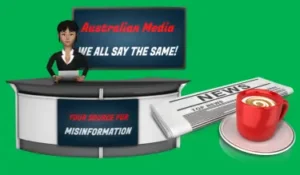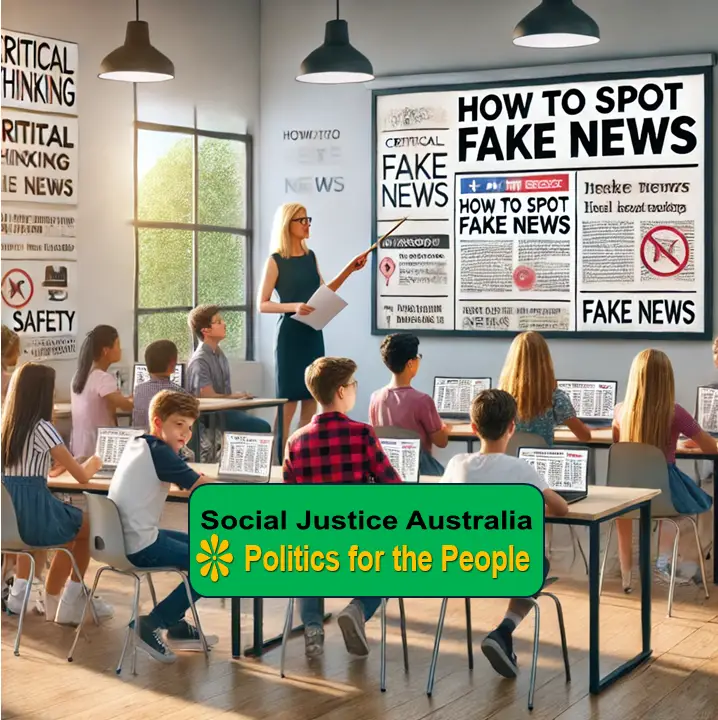Description
Media literacy. How Australia can combat misinformation in schools by teaching critical thinking. Learn how Finland’s model can inspire change and overcome resistance.
Introduction

In an era where misinformation spreads rapidly online, teaching children to navigate and critically evaluate media is essential. Misinformation and “fake news” affect public discourse, influencing elections, public health, and everyday decisions. Australia can adopt a proven approach to combat misinformation by incorporating smart media habits in schools.
Finland’s education system provides an exemplary model for fostering critical thinking in young minds, preparing them to become informed citizens. This article explores how Australia can implement a similar program, highlights the key teaching resources used in Finland, addresses barriers to adoption, and offers solutions to overcome resistance.
Key Elements of Finland’s Content Evalution Skills Program
Early Introduction to Media Literacy
Finland’s approach begins in early childhood education. Fact-based media engagement is taught alongside foundational subjects, enabling children to recognize credible information sources and question narratives from an early age. Preschoolers are introduced to simple lessons, such as showing the difference between fiction and fact in storytelling.
Phenomenon-Based Learning (PhBL): This method encourages holistic exploration of real-world topics rather than studying isolated subjects. For example, students may explore a theme like “climate change” through science, history, and digital literacy, fostering cross-disciplinary critical thinking.
Takeaway for Australia: Introducing age-appropriate media literacy early can develop foundational critical thinking skills. Activities such as “spot the true story” can engage children in understanding the importance of fact-based information.
Cross-Curricular Integration
In Finland, critical thinking skills are not limited to one subject. Media literacy is embedded across subjects, including history, language, and digital literacy. Students practice analysing different forms of information, from historical texts to online news articles, fostering a well-rounded skill set.
Collaborative Learning: Finland’s emphasis on teamwork in classroom settings promotes deeper reflection and analysis. By discussing and debating different viewpoints, students learn to evaluate claims critically.
Takeaway for Australia: Embedding media literacy in multiple subjects, such as Civics and Citizenship, can make it a core competency, rather than an optional add-on. Collaborative group projects can enhance engagement and understanding.
Hands-On Practical Exercises
To combat misinformation, Finnish students engage in practical exercises, such as comparing news sources and finding biases. They even create their own fake news stories to understand how misinformation is crafted and spread.
Creative Education: Finnish students often use storytelling and creative projects to explore how information can be manipulated, which enhances their ability to spot misleading narratives.
Takeaway for Australia: Practical, interactive lessons that mimic real-world scenarios help students apply their critical thinking skills outside the classroom. Creative projects, such as digital storytelling or creating mock news reports, can deepen understanding.
Teacher Training Programs
Educators in Finland undergo specialized training to teach media literacy effectively. This ensures that they can guide students in evaluating information critically and navigating online spaces safely.
Training Programs: Finland’s teacher training includes programs such as Finland Studies MOOCs, which provide educators with resources to integrate creativity and media literacy into the classroom.
Takeaway for Australia: Providing teachers with professional development workshops focused on media literacy ensures they have the resources to implement effective lessons.
Government and Community Support
The Finnish government plays an active role in supporting media literacy programs, recognizing their importance in supporting a healthy democracy. Public institutions, civil organizations, and schools collaborate to strengthen digital resilience.
Innovative School Design: Finnish schools are designed to support modern instructional methods, such as team teaching and collaborative projects. Flexible classroom layouts help interactive learning.
Takeaway for Australia: A whole-of-community approach, supported by public funding, can ensure the sustainability of media literacy programs. Designing classrooms that support collaboration can enhance program effectiveness.
Implementing Media Literacy in Australian Schools
Early Integration in Primary and Secondary Schools
Australia can introduce media literacy in early primary years, building on foundational lessons as students’ progress to higher grades. For example, early lessons could focus on recognising facts versus opinions, while high school lessons could delve into finding logical fallacies and understanding algorithms.
Curriculum Framework Suggestions
Incorporating media literacy into the Digital Technologies, English, and Humanities curricula can foster critical thinking and digital citizenship. Sample lesson plans can include tasks such as:
• Comparing news articles for bias.
• Researching the origins of viral posts.
• Discussing ethical journalism.
Educator Training and Professional Development
Training workshops and access to digital resources can equip teachers with the necessary tools. Partnerships with universities and media literacy organisations can ensure continuous professional development.
Cross-Sector Collaboration
Collaboration between schools, universities, and community groups can strengthen media literacy programs. Engaging journalists, fact-checking organisations, and tech experts as guest speakers can enrich the learning experience.
Potential Barriers to Implementation
Political and Ideological Resistance
Media literacy programs may face resistance from groups that perceive them as politically biased. Some critics argue that teaching students to question media narratives could lead to distrust in traditional institutions.
Solution: Frame media literacy as a non-partisan skill that promotes civic engagement rather than political ideology. Highlight its benefits for democracy and informed debate.
Lack of Funding and Resources
Schools may struggle to implement innovative programs without more funding for resources and training.
Solution: Advocate for public funding dedicated to media literacy programs. Explore partnerships with non-profits and grants to secure supplementary funding.
Outdated Educational Structures
Slow curriculum reform processes may hinder the introduction of media literacy.
Solution: Pilot programs in select schools to show the effectiveness of media literacy lessons, creating momentum for broader implementation.
Pushback from Media Corporations
Media corporations may resist scrutiny, fearing that critical analysis could reduce public trust in their content.
Solution: Engage in open discussions with media organisations, emphasising the importance of restoring public trust through transparency and media accountability.
Overcoming Barriers to Media Literacy Implementation
Building Public Awareness and Support
Public campaigns highlighting the benefits of media literacy can build community support. Sharing success stories from other countries like Finland can show its positive impact.
Bipartisan Political Support
Gaining support across political parties by framing media literacy as a tool for protecting democracy can reduce partisan resistance.
Securing Adequate Funding
Public investment in education must prioritize media literacy. Government funding for professional development and digital tools is crucial for long-term success.
Continuous Curriculum Updates
Regularly updating media literacy content to address new misinformation trends ensures its relevance. Advisory panels including educators, journalists, and tech experts can guide revisions.
Empowering Teachers and Students
Providing educators with flexible lesson plans and students with leadership opportunities—such as running school fact-checking initiatives—can foster ownership and engagement.
Measuring the Impact of Media Literacy Programs
• Use student assessments and surveys to measure improvements in media analysis skills.
• Track civic engagement metrics, such as participation in discussions and community projects.
• Conduct research studies to evaluate long-term impacts on digital resilience and critical thinking.
Conclusion
Media literacy education equips students with essential critical thinking skills needed to navigate an increasingly digital world. By adopting a comprehensive, whole-of-community approach inspired by Finland’s model, Australia can foster informed, resilient citizens capable of combating misinformation.
Implementing these programs will require overcoming funding challenges and ideological resistance, but the benefits for democracy and informed citizenship make it a worthy investment.
Question for Readers
What steps can Australia take to ensure every student develops strong media literacy skills?
Call to Action
Do you see opportunities for community-driven change in Australia’s dollar sovereignty? If you found this article insightful, explore more about political reform and Australia’s monetary sovereignty on Social Justice Australia: https://socialjusticeaustralia.com.au/.
Share this article with your community to help drive the conversation toward a more just and equal society.
Click on our “Reader Feedback” menu. Let us know how our content has inspired you. Submit your testimonial and help shape the conversation today!
Additionally, leave a comment about this article below.
Q&A Section
Q: What is media literacy, and why is it important?
A: Media literacy is the ability to critically evaluate information across different platforms. It helps individuals find credible information, avoid misinformation, and take part in informed discussions.
Q: How can schools implement media literacy without political bias?
A: By focusing on skills such as finding biases and logical fallacies rather than promoting specific viewpoints, schools can support a neutral approach.
Q: What role do parents play in supporting media literacy?
A: Parents can reinforce media literacy at home by encouraging discussions about current events, checking online content, and teaching children to question sources.
Support Social Justice Australia – Help Keep This Platform Running
Social Justice Australia is committed to delivering independent, in-depth analysis of critical issues affecting Australians. Unlike corporate-backed media, we rely on our readers to sustain this platform.
If you find value in our content, consider making a small donation to help cover the costs of hosting, maintenance, and continued research. No matter how small, every contribution makes a real difference in keeping this site accessible and ad-free.
💡 Your support helps:
✅ Keep this website running without corporate influence
✅ Fund research and publishing of articles that challenge the status quo
✅ Expand awareness of policies that affect every day Australians
💰 A one-time or monthly donation ensures Social Justice Australia stays a strong, independent voice.
Thank you for being part of this movement for change. Your support is truly appreciated!

